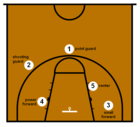Point guard

The point guard [ pɔɪnt gɑːɹd ] (German mutatis mutandis point guard ) is one of five positions in basketball . Together with the shooting guard he forms the backcourt . The point guard is also called the playmaker and is usually the player with the best ball handling on a basketball team. He's usually the smallest player in the starting five .
Requirements and style of play
As a rule, the point guard is very quick and agile and has excellent ball handling. His game overview is also of great importance, because the point guard decides when which turn is started. He must therefore also be characterized by wise decisions. The point guard is a kind of "extended arm" of the trainer on the field.
The most famous point guards include Bob Cousy , John Stockton , Isiah Thomas , Jason Kidd , Derrick Rose , Russell Westbrook , Stephen Curry , Chris Paul and Steve Nash . An exception to the usual definition of a point guard as the smallest player are Oscar Robertson (1.96 m) and Magic Johnson (2.06 m). Despite their size, both had point guard skills, which all in all made them the best players in their position.
history
Nat Holman , who played for the New York Whirlwinds and the Original Celtics in the 1920s, is usually referred to as the first real development player. He was one of the first to direct the moves on the field. At that time, however, the division into guard (= defender) and forward (= attacker) still applied, which is why Holman ran up as a forward.

Bob Cousy of the Boston Celtics is now considered a revolutionary of the point guard position. Initially ridiculed for his confused-looking way of passing, Cousy turned out to be the dominant guard of the 1950s and, with his passing game, became a role model for generations of subsequent guards. Marques Haynes from the Harlem Globetrotters is now regarded as a revolutionary in ball handling. Haynes was probably the first to dribble behind the back and through the legs and, like Cousy, found numerous imitators in subsequent Guard generations.
The 1960s saw Oscar Robertson as the first forward to take on the duties of the guard. Since then, this style of play has been emulated by a few outstanding NBA players, including Magic Johnson , Scottie Pippen , Grant Hill and LeBron James . Another player of this style of play, Paul Pressey, coined the term point forward in the mid-1980s . Since these players defended the tasks of the point guard in attack, but defended the opposing shooting guards or small forwards in defense, they were usually assigned a smaller player to defend the opposing point guard (for example Byron Scott at Magic Johnson).
Although classic ball distributors such as assist record holder John Stockton , Mark Jackson , Jason Kidd and two-time MVP winner Steve Nash were also to be seen in the 1990s and the new millennium , new types of point guards were increasingly emerging: bigger and stronger players like Gary Payton or Chauncey Billups often acted close to the basket, where they could score more easily against smaller opponents. In the 2007/08 NBA season , Chris Paul, a classic point guard, achieved a player efficiency rating of 28.3 and thus the highest value that a PG could ever achieve. Paul came in second in the 2008 MVP election, behind Shooting Guard Kobe Bryant .
Today there are many different types of point guards who act very differently on the field. There are point guards who attach particular importance to scoring points (e.g. Russell Westbrook ), in contrast to those who mainly distribute assists (e.g. Rajon Rondo ). There are also point guards who have found a balance between scoring and assisting (e.g. Tony Parker ). In the late 2000s, this position produced many athletic and strong scoring point guards. In addition to Westbrook, there are also John Wall , Derrick Rose , Stephen Curry , Damian Lillard , Kyle Lowry and Kyrie Irving , who redefined this position.
See also
literature
- Sven Simon: Point Guard History . In: Five , 3/2005, pp. 40-44.
Web links
|
||||||||||||||||||||||

